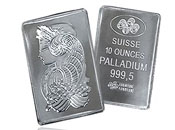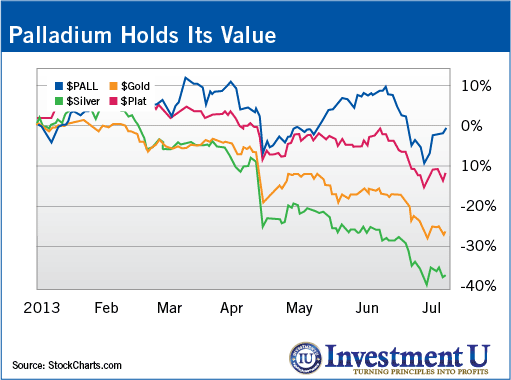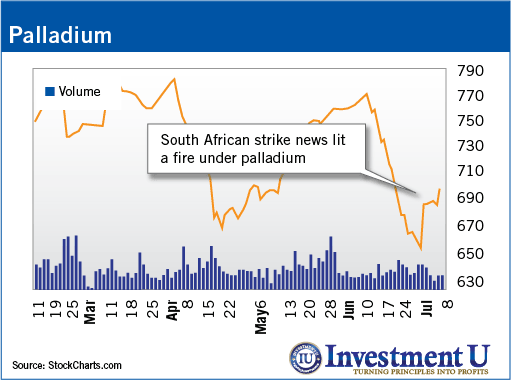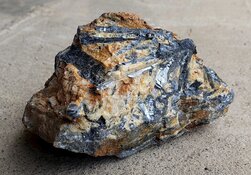
More importantly, you can profit from palladium's bullish trend.
Looking at the chart below, you can see that while gold and silver have been crushed—down more than 25% and 36%, respectively, this year alone—palladium has held up well.

Palladium is holding up nicely while gold and silver scrape bottom.
As for platinum (NYSEARCA:PALL), it has dropped only half as much as gold because it sharestwo of palladium's attributes—scarcity and industrial demand. Both are used in automobile catalytic converters.
To be sure, I think the pullback in gold and silver is an incredible buying opportunity—one that could richly reward investors who have patience and fortitude. But for investors who have been burned by gold's slump, the good news is that palladium doesn't require patience—there are forces lining up to push it even higher right now.
Those forces include. . .
- Labor Troubles. South Africa produces 36% of the world's palladium (most of the rest comes from Russia). Thousands of South African mine workers are on strike. Labor disputes are lingering, ongoing and bitter. As a result, 250,000 ounces of palladium production were lost last year. Until new agreements can be established, this is a bullish force in the market. Importantly—and I can't emphasize this enough—the most recent strike is already priced in. But that's OK. It's going to lead to a buying opportunity in palladium that I'll get to shortly.
- Global Shortage. The deficit between production and demand is high. According to Thomson Reuters GFMS, in 2012 the palladium market recorded its highest deficit in 11 years—1.122 million ounces. Mines produced just 8.7 million ounces while demand rose to 9.32 million ounces. In fact, palladium demand has doubled in the past decade.
- Russia Is in Decline. Russian production of palladium dropped 3% in 2012. But the bigger problem is that Russia's sales of its strategic palladium supply—the only such strategic supply in the world—dropped sharply last year to 250,000 ounces—a 68% decline year over year, according to precious metals consultancy Johnson Matthey. This year, Johnson Matthey expects that Russia will sell fewer than 100,000 ounces from its stockpile. Johnson Matthey told reporters in January that "Russian state stockpiles have been dwindling and are now pretty much exhausted." Meanwhile, Russia's Norilsk Nickel, the world's largest producer of the metal (41% of global output), says its production will drop 3.2% this year. It also expects the global supply/demand shortfall to get worse for years to come.
- Surging Car Sales. About 90% of palladium production was used in the automobile industry last year. Economists, analysts and car companies expect the United States to buy between 15.4 million and 16 million cars this year. That's up as much as 7.4% from 2012. The same trend is taking place in China, which passed the U.S. in total car sales back in 2009.
Classic Bull Market Setup
Supply is tightening while demand is rising. In other words, palladium is in a classic bull market setup. Now, let's look at one last chart. . .

Looking at the chart, you can see that palladium has bounced sharply off its lows, fueled by the latest strikes out of South Africa. My target on the metal is $830.
But you'll recall my contention that the South African strikes would lead to a future buying opportunity. The current strike is already factored into the price of palladium, so I suggest waiting until it ends.
Palladium will pull back on the news, and that's when you buy. There will be another strike down the road because there is no real long-term solution to the conflict between spiraling costs of South African palladium/platinum producers and the expectations of the workers.
How to Invest
The major palladium producers are a sad bunch. I wouldn't recommend any of them. There are some palladium mine developers I like a lot, but they need constant attention.
That leaves us two tradable palladium ETFs. . .
ETFS Physical Palladium Shares(NYSEARCA:PALL) holds physical palladium and tracks the price closely. It has average daily volume of 127,000 and charges a 0.49% yearly fee.
Sprott Physical Platinum and Palladium Trust(NYSEARCA:SPPP) holds both platinum and palladium bullion. It has average daily volume of 268,800, and total annual expenses are 0.85%. Sprott offers an interesting twist: shareholders can redeem their shares for physical bullion on a monthly basis. However, the minimum is 25,000 units, so you better have deep pockets.
Bottom line: Buy palladium on the next pullback, because the Rodney Dangerfield of metals is poised to get a lot more respectable this year.
Good investing,
Sean Brodrick
ETF Daily News



































